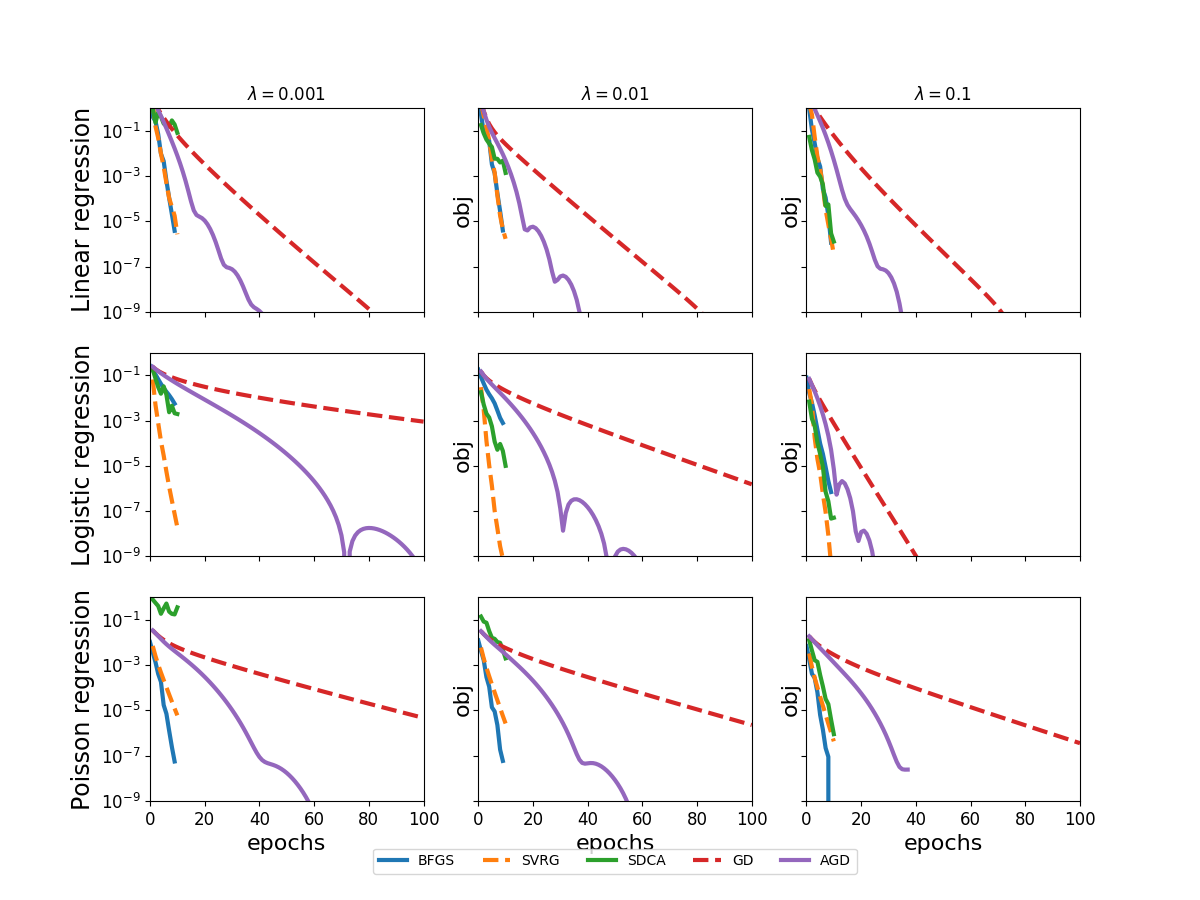Generalized linear models solver convergence¶
- This example illustrates the optimization of three linear models:
Linear regression (
tick.optim.model.ModelLinReg)Logistic regression (
tick.optim.model.ModelLogReg)Poisson regression (
tick.optim.model.ModelPoisReg)
- with five different solvers:
LBFGS (
tick.solver.BFGS)SVRG (
tick.solver.SVRG)SDCA (
tick.solver.SDCA)GD (
tick.solver.GD)AGD (
tick.solver.AGD)

Python source code: plot_glm_convergence.py
import matplotlib.pyplot as plt
from tick.plot import plot_history
import numpy as np
from itertools import product
from tick.linear_model import SimuLinReg, SimuLogReg, SimuPoisReg, \
ModelLinReg, ModelLogReg, ModelPoisReg
from tick.solver import SDCA, SVRG, BFGS, GD, AGD
from tick.prox import ProxZero, ProxL2Sq
seed = 1398
np.random.seed(seed)
def create_model(model_type, n_samples, n_features, with_intercept=True):
weights = np.random.randn(n_features)
intercept = None
if with_intercept:
intercept = np.random.normal()
if model_type == 'Poisson':
# we need to rescale features to avoid overflows
weights /= n_features
if intercept is not None:
intercept /= n_features
if model_type == 'Linear':
simulator = SimuLinReg(weights, intercept=intercept,
n_samples=n_samples, verbose=False)
elif model_type == 'Logistic':
simulator = SimuLogReg(weights, intercept=intercept,
n_samples=n_samples, verbose=False)
elif model_type == 'Poisson':
simulator = SimuPoisReg(weights, intercept=intercept,
n_samples=n_samples, verbose=False)
labels, features = simulator.simulate()
if model_type == 'Linear':
model = ModelLinReg(fit_intercept=with_intercept)
elif model_type == 'Logistic':
model = ModelLogReg(fit_intercept=with_intercept)
elif model_type == 'Poisson':
model = ModelPoisReg(fit_intercept=with_intercept)
model.fit(labels, features)
return model
def run_solvers(model, l_l2sq):
try:
svrg_step = 1. / model.get_lip_max()
except AttributeError:
svrg_step = 1e-3
try:
gd_step = 1. / model.get_lip_best()
except AttributeError:
gd_step = 1e-1
bfgs = BFGS(verbose=False, tol=1e-13)
bfgs.set_model(model).set_prox(ProxL2Sq(l_l2sq))
bfgs.solve()
bfgs.history.set_minimizer(bfgs.solution)
bfgs.history.set_minimum(bfgs.objective(bfgs.solution))
bfgs.solve()
svrg = SVRG(step=svrg_step, verbose=False, tol=1e-10, seed=seed)
svrg.set_model(model).set_prox(ProxL2Sq(l_l2sq))
svrg.history.set_minimizer(bfgs.solution)
svrg.history.set_minimum(bfgs.objective(bfgs.solution))
svrg.solve()
sdca = SDCA(l_l2sq, verbose=False, seed=seed, tol=1e-10)
sdca.set_model(model).set_prox(ProxZero())
sdca.history.set_minimizer(bfgs.solution)
sdca.history.set_minimum(bfgs.objective(bfgs.solution))
sdca.solve()
gd = GD(verbose=False, tol=1e-10, step=gd_step, linesearch=False)
gd.set_model(model).set_prox(ProxL2Sq(l_l2sq))
gd.history.set_minimizer(bfgs.solution)
gd.history.set_minimum(bfgs.objective(bfgs.solution))
gd.solve()
agd = AGD(verbose=False, tol=1e-10, step=gd_step, linesearch=False)
agd.set_model(model).set_prox(ProxL2Sq(l_l2sq))
agd.history.set_minimizer(bfgs.solution)
agd.history.set_minimum(bfgs.objective(bfgs.solution))
agd.solve()
return bfgs, svrg, sdca, gd, agd
model_types = ['Linear', 'Logistic', 'Poisson']
l_l2sqs = [1e-3, 1e-2, 1e-1]
fig, axes = plt.subplots(
len(model_types), len(l_l2sqs),
figsize=(4 * len(l_l2sqs), 3 * len(model_types)), sharey=True, sharex=True)
n_samples = 1000
n_features = 20
for (model_type, l_l2sq), ax in zip(
product(model_types, l_l2sqs), axes.ravel()):
model = create_model(model_type, n_samples, n_features)
bfgs, svrg, sdca, gd, agd = run_solvers(model, l_l2sq)
plot_history([bfgs, svrg, sdca, gd, agd], ax=ax, dist_min=True,
log_scale=True)
ax.legend_.remove()
ax.set_xlabel('')
ax.set_ylim([1e-9, 1])
for l_l2sq, ax in zip(l_l2sqs, axes[0]):
ax.set_title('$\lambda = %.2g$' % l_l2sq)
for model_type, ax in zip(model_types, axes):
ax[0].set_ylabel('%s regression' % model_type, fontsize=17)
for ax in axes[-1]:
ax.set_xlabel('epochs')
axes[-1][1].legend(loc=9, bbox_to_anchor=(0.5, -0.2), ncol=5)
plt.show()
Total running time of the example: 2.34 seconds ( 0 minutes 2.34 seconds)
- Mentioned tick classes: